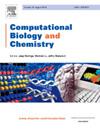Design of BBB permeable BACE-1 inhibitor as potential drug candidate for Alzheimer disease: 2D-QSAR, molecular docking, ADMET, molecular dynamics, MMGBSA
IF 2.6
4区 生物学
Q2 BIOLOGY
引用次数: 0
Abstract
BACE-1 is a prime therapeutic target for treatment of Alzheimer disease as it cleaves the β-site of APP leading to formation of amyloid plaques. A dataset of 229 benzo-fused heterocyclic compounds reported as BACE-1 inhibitors was utilized to develop various QSAR models (regression and classification) utilizing Monte Carlo algorithm. The dataset was randomly split into different sets for generation of models. The IIC and CCC were calculated to increase the predictive ability of generated models. Among various models, split-1 of Model-1 demonstrated the highest robustness and predictive accuracy for pIC50 values. Internal and external validation was performed which further confirmed the reliability of this model. Structural features responsible for enhancing or reducing pIC50 values were identified and were utilized to design library of 255 compounds. Compounds having pIC50 > 5.0 were further screened on the basis of BBB permeability predicted via ADMET lab 3.0. Total nineteen compounds were found to be BBB permeable which were then docked into PDB: 2WJO. Finally, four compounds with high docking scores were identified and compared with existing BACE-1 inhibitor. MD simulations and MMGBSA analysis were performed and results demonstrated minimal fluctuations throughout the simulation of 100 ns with good binding affinity. This study highlights development of robust QSAR model which assists to design new compounds and predicts them for anti β-secretase activity. Design of novel four molecules were proposed which exhibits good potency, BBB permeability, excellent binding affinity and stable conformations with BACE-1 making them promising candidates for further development.
求助全文
约1分钟内获得全文
求助全文
来源期刊

Computational Biology and Chemistry
生物-计算机:跨学科应用
CiteScore
6.10
自引率
3.20%
发文量
142
审稿时长
24 days
期刊介绍:
Computational Biology and Chemistry publishes original research papers and review articles in all areas of computational life sciences. High quality research contributions with a major computational component in the areas of nucleic acid and protein sequence research, molecular evolution, molecular genetics (functional genomics and proteomics), theory and practice of either biology-specific or chemical-biology-specific modeling, and structural biology of nucleic acids and proteins are particularly welcome. Exceptionally high quality research work in bioinformatics, systems biology, ecology, computational pharmacology, metabolism, biomedical engineering, epidemiology, and statistical genetics will also be considered.
Given their inherent uncertainty, protein modeling and molecular docking studies should be thoroughly validated. In the absence of experimental results for validation, the use of molecular dynamics simulations along with detailed free energy calculations, for example, should be used as complementary techniques to support the major conclusions. Submissions of premature modeling exercises without additional biological insights will not be considered.
Review articles will generally be commissioned by the editors and should not be submitted to the journal without explicit invitation. However prospective authors are welcome to send a brief (one to three pages) synopsis, which will be evaluated by the editors.
 求助内容:
求助内容: 应助结果提醒方式:
应助结果提醒方式:


